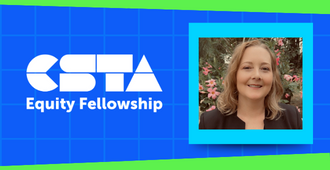
K-12 students with disabilities are successful in computer science (CS) when they receive instruction that is flexible and accessible.
Full Story
K-12 students with disabilities are successful in computer science (CS) when they receive instruction that is flexible and accessible. To enable teachers to improve CS education for this broad population of learners through inclusive lesson planning and implementation, we created a resource called the Universal Design for Learning for CS (UDL4CS) Interactive Table. In this article, we highlight the design of the UDL4CS Interactive Table and discuss how to use it in practice.
The Full Story
The term CS for All is used a great deal in the CS education field. What do we mean by this? Who’s included in these discussions? The idea of CS for All is that computer science instruction is important for all students. We believe this means all students, including ones with disabilities, should receive computer science education along with necessary support structures.
Recent statistics indicate that in the United States, approximately 7.2 million students (or about 15% of the population) receive special education services for an identified disability. Including students with disabilities is generally required in the U.S. by the Individuals with Disabilities Education Act (IDEA) and Section 504 of the Rehabilitation Act of 1973. Therefore, these students must be included in computer science. When students are given appropriate support and accessible tools/curricula, they can succeed. Yet, inclusion of students with disabilities is often hampered by low expectations, as well as pedagogical and accessibility barriers which keep them from being fully included.
Contrastingly, Universal Design for Learning (UDL) is a framework that proactively facilitates the needs of all learners by considering instructional goals, reducing barriers, and supporting students to become expert learners. This framework can improve inclusion in K-12 CS education by providing specific guidelines on making the curriculum engaging and accessible. UDL is supported by CSTA Teacher Standards 4c (“design inclusive learning experiences”) and 2e (“use accessible instructional methods”). However, it can be difficult to implement UDL in the classroom since the guidelines are complex and not yet widely implemented in the context of K-12 CS education. Presented below is a resource created at the University of Florida’s Creative Technology Research Lab (CTRL) to make it easier for current and future teachers to implement UDL in their own practices.
Introducing the UDL4CS Interactive Table
We created the UDL4CS Interactive Table based on a previous text-based version (Figure 1) which was useful, but we wanted to give users more options to interact with the information and make the content more concise.

Figure 1: Part of previous text-based UDL4CS table. Adapted from CAST (2014). Universal design for learning guidelines version 2.1 [graphic organizer]. CAST, Inc. ©2014 CAST Inc. Used with permission. All rights reserved.
Our interactive table (See Figure 2) improves upon the previous resources on UDL-based CS education and has been updated to reflect the current guidelines. Now, let’s explore the Interactive Table’s design features and how to use it.

Figure 2: Part of the UDL4CS Interactive Table with videos and links to text.
Interactive Table’s design features
-
Clear explanations of guidelines and CS-specific checkpoints in both written and video formats.
-
Links to CAST’s graphic organizer and guideline definitions (See figure 3).
-
Specific examples of how to apply the UDL guidelines within K-12 CS education.

Figure 3: Screenshot: CAST Graphic Organizer. CAST(2018). Universal Design for Learning Guidelines Version 2.2. Retrieved October 19, 2022 from https://udlguidelines.cast.org. © 2018, CAST, INC. Used with permission. All Rights Reserved.
Using the Table in Practice
The UDL Implementation Research Network has five steps for successful implementation. Integrating these steps with our table allows teachers to use these steps in an easy to understand way which we elaborate on below.
-
Establish Clear Goals: Using “I can” statements is helpful for establishing the goals of the lesson. These statements communicate to learners what they should know and allow ways to check for understanding. We like to use a thumbs up or thumbs down method to do this. Before you use the table, it is helpful to think about what it is that you want students to accomplish. Establishing clear goals helps us understand what students need to do in order to complete the learning task.
-
Anticipate learner needs and barriers: Thinking about background knowledge, preferences, and potential threats to learning will help you better understand how you need to design so that you will better be able to locate what you need from the table. The first consideration in this category is of the learner’s strengths and weaknesses relative to the lesson plan. Then, we consider what sort of background knowledge the learner has. For instance, knowledge of an algorithm would precede loops. Third, we consider learner preferences for representation, expression, engagement, and language. We also want to consider the learner’s culture and how they understand things which may include, but are not limited to, race/ethnicity, country of origin, and age. Finally, note any barriers to learning that students may encounter.
-
Measurable outcomes and assessment plan: In this step, we make a plan to support high expectations for all students, including students who may be on the margins with barriers to learning. Our table provides suggestions on how to accomplish multiple representations for assessing learning outcomes. You can either use these suggestions or treat the examples as catalysts to think about needs in your own individual practice. To implement the outcomes and assessment plan, we need to think about the multiple ways students can represent that information. First examine the goals and barriers you identified earlier. Next, decide on things learners should be accomplishing as waypoints in their projects. Finally, students should have multiple representations for engagement, action, and demonstrating understanding.
-
Instructional Experience: Here, you can further use the UDL4CS Interactive Table to address barriers to learning. We identify common barriers in computer science and suggest ways to meet UDL checkpoints. These suggestions can either be used in practice or as ways to jumpstart your thinking.
-
Reflect: In the final step, we can reflect on whether we may need to see more Interactive Table videos/resources or otherwise improve the lesson. Did the learners understand the main point of the lesson? What tools and strategies worked and how did they support UDL principles; if not, how could they be improved?
Discussion
Practices like UDL help teachers successfully implement inclusive practices in the classroom. The field of computer science is ripe for the type of learning innovation that Universal Design for Learning provides. For teachers, our UDL4CS resource acts as a powerful tool for improving knowledge of inclusive practices.
In order to effectively create an inclusive CS environment, teachers must be able to fully integrate UDL practices into instruction. Because our Interactive Table connects the UDL guidelines to practical examples, it is a useful resource for teachers who want to make their classroom more accessible and engaging. Use of the UDL4CS table combined with the UDL-IRN’s framework creates an environment that includes all students in computer science and provides strategies that enable them to succeed. It is our hope that the UDL4CS table will help break down barriers to the success and inclusion of all students in computer science.
Acknowledgment
The UDL4CS Interactive Table was produced under National Science Foundation Grant #2031233. Its continued expansion is being supported using funding from Google. This article does not necessarily reflect the views and opinions of the National Science Foundation or Google.
About the Authors
Andrew Bennett is a Research Assistant at the CTRL Lab and Ph.D. student in Education Technology at the University of Florida. Before UF, he did UDL and assistive technology work in K-12 and higher educational contexts. He also previously worked in the writing center field in higher education and as a research assistant for the Creative Computing Lab at the Harvard Graduate School of Education.
Maya Israel, Ph.D. is an associate professor of Educational Technology and Computer Science Education at the University of Florida. She is the Director of the Creative Technology Research Lab at UF and a former special education teacher. Her research focuses on students with disabilities and other academically diverse learners in order to create strategies which engage them in computer science education through Universal Design for Learning.
Johnny Delgado is a member of the Griffin CS For All Initiative. His primary focuses are in developing a microcredential to introduce pre-service teachers to computer science (CS) and supporting the development of teacher candidates at P.K. Yonge School. Before his employment at UF, Johnny worked in secondary education promoting project-based cross-disciplinary learning, and teaching AP CS and Virtual Reality Video Game Design/Development.




